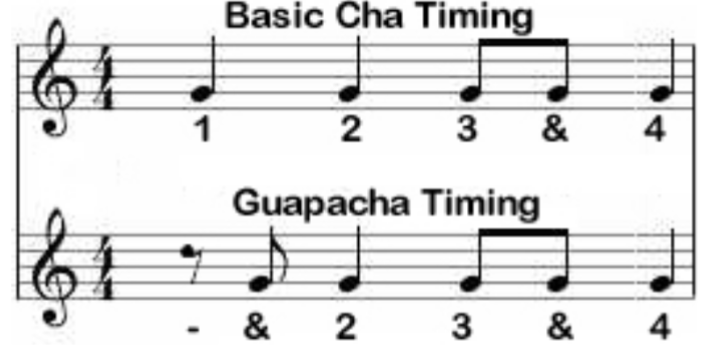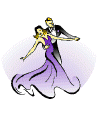|
|
Guapacha
by Sandi
& Dan Finch
Guapa who? Guapacha (pronounced wha-pah-cha) is a timing variation for
Cha Cha. The English brought it into ballroom dance to fancy up some
basic steps to make them more interesting. It is limited in competition
to those at the silver (intermediate) level and above. But, of course,
it wound up in round dancing too.
 It can modify the timing for steps like the basic or time step, from
the standard 123&4 to &23&4 (counting the beats you
actually step on), as described in the Roundalab Glossary of Standards.
This is done by holding the first half of the first beat (count 1, the
downbeat), followed by a quick step on the second half of count 1,
recover on count 2 and then dance the standard cha cha chasse. It can
be described as hold/&, quick, quick/&, quick. [Note: Nothing
is ever simple -- other variations of this timing can be found.]
It can modify the timing for steps like the basic or time step, from
the standard 123&4 to &23&4 (counting the beats you
actually step on), as described in the Roundalab Glossary of Standards.
This is done by holding the first half of the first beat (count 1, the
downbeat), followed by a quick step on the second half of count 1,
recover on count 2 and then dance the standard cha cha chasse. It can
be described as hold/&, quick, quick/&, quick. [Note: Nothing
is ever simple -- other variations of this timing can be found.]
We have seen it used several times in round dancing over the years for
variation -- in the Turkish towel in Shibata’s Chilly Cha in 2004 and
more recently in Gosses’ Drive My Car, which uses it with the unphased
figures continuous cucarachas and continuous back breaks.
So where does it come from and what does it mean? The word “guapacha”
itself means friendly, happy or something different, depending on which
Caribbean or South American dialect you translate.
The term was originally applied to music in Cuba. A new form of Cha Cha
was named in honor of the Cuban singer and drummer Amado Borelá, whose
nickname was “Guapacha.” Borelá was known for his contributions to
music and dance, mainly through mixing American jazz into the Cuban
sound. He died suddenly at age 32 in 1966, but his few recordings are
still available online -- Amazon, YouTube, Spotify, Apple -- and his
one album is called “a jewel of collectibles and cult.”
A similar timing variation is used in Rumba in ballroom competition. It
is called “habanera timing,” and similar to Cha Cha, you hold the first
half of the first beat, then step quickly on the second half of that
beat, then a quick recover step, then the slow third step on two beats,
i.e., hold & quick slow. According to Ballroomguide. com, these
alternative timings can “make your dancing slightly unexpected, and
therefore more interesting” for you and for judges, but should be used
sparingly. As an example, it suggested using basic timing for an open
hip twist but dancing the movement out to fan in guapacha (or habanera)
timing.
Cha cha itself is a derivation of earlier Cuban forms of the mambo. It
came to be a modern ballroom rhythm through American and British
visitors to Cuba. A British dance teacher named Pierre Zurcher-Margolle
(known as Monsieur Pierre) began going to Cuba in the mid-1940s to
study what was being done there. He is credited with introducing Latin
dances to England, codifying them and laying the groundwork for their
use in competition. He founded the Latin style section of the Imperial
Society of Teachers of Dancing (ISTD) and established a syllabus in use
internationally today.
Pierre reportedly saw the dance he called cha cha cha on a trip to Cuba
in 1952. It was added to his ISTD syllabus by 1955 as the fifth rhythm
to be used in International Latin competitions.
Some people say the rhythm was named for the sound of feet shuffling
through the characteristic triple step. Others say the name came from a
rattle used by Latin bands, called a cha-cha (maracha) and made with
seed pods called tcha-tcha or kaw-kaw. Still others say Pierre borrowed
the name of a lively German dance popular from the late 1800s called
Guaracha.
What Pierre saw was a rhythm heavily influenced by Americans. Cuba with
its rum factories and cigars had become a tourist mecca during American
Prohibition. Up until the US severed relations with Cuba in 1962,
American orchestras were booked to play the casinos of Havana, and
their music mingled with the Latin rhythms being played there. Jazz
fused with the Caribbean mambo to create a dance of three quick weight
changes followed by two slows, called triple mambo or chatch. (It was
also called mambo with a guiro, named for the dried gourd rubbed with a
serrated stick in Latin bands to make the characteristic cha cha beat.)
The new sounds of Havana were unlike anything heard in North America or
Europe. The music first came to the United States in 1949 with musician
Minon Mondajar. Arthur Murray liked it but slowed the music, changed
the Cuban steps and called it Cha Cha. It became a rage with the music
of Perez Prado in the 1950s.
Latin rhythms were not part of the original round dance repertoire. Cha
Cha, along with Rumba and Jive, were not added to the RAL Manual of
Standards until 1979, three years after the organization was formed.
Cha Cha now begins in the Manual at Phase III but has modernly been
used as the first rhythm taught to beginning round dancers.
From a club
newsletter, June 2025,
and
reprinted
in the Dixie Round Dance Council (DRDC)
Newsletter, September 2025. Find a DRDC Finch archive here.

|
